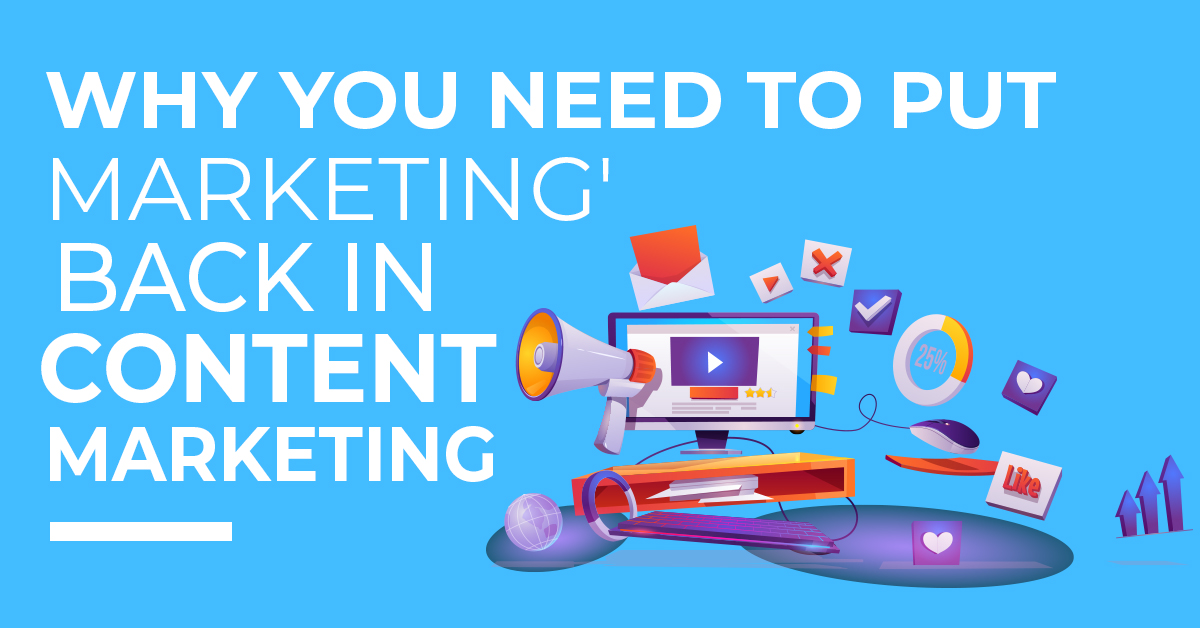The internet is getting polluted with more and more shitty content each day, putting marketing back in content marketing is the real deal. And answering why is content marketing important either for your business or the client, is non-negotiable.
Why is content marketing important?
Content marketing has become the center of attention in the digital world today, especially since the last decade. However, the confusions surrounding its scope and goals have come with equal share.
Here are some incredible statistics depicting the growth, current and future trends, and the untapped potential and preferences in the grand content marketing arena.


Back in the day…
Only a decade back, there was no noticeable debate on why is content marketing important as companies were unsure if they could make a fortune through an online presence. Furthermore, the algorithms and systems to rank websites and content pieces weren’t smart enough.
Companies used to blog, and some were often enjoying success in their specific industries because they had unlocked the potential what others in the market hadn’t—establishing goodwill with their customer base through content as the most powerful way to market their business.
Then came the Penguin update in 2012 when the digital world began to visibly shift, entire industries and big companies experienced a drastic decline within a single move. However, if you’re aware of the SEO chronicles, you’ll know that this went through more than 20 changes in the Penguin algorithm, which aimed to target activities like manipulative link building through paid links and other things.
Although such activities are still in place, but the global industry has seen some major changes over the course to this day.
This brings us back to content marketing professionals who are mainly about extensive blogging and working through link building recipes to drive SEO efforts.
But where is “marketing” in content marketing?
Or rather it’s more about creating content to push up the link graph in order to get ranked by the search engines. Evidently, mostly that’s the case.
But what does it mean to incorporate marketing in content. How digital marketing professionals should stop using content as a bait to attract links and propel rankings, and rather use content to nourish businesses in a holistic manner.
What industry influencers have to say…?
According to Ahava Leibtag, the Founder of Aha Media Group, most of the digital world is making content only for sake of “creating content”, rather they should create to move the needle.
The needle here indicates doing more organic research on audiences and using the information to craft powerful marketing strategies.
Furthermore, as Henry Rollins, a media personality and artist, speaks at the Content Marketing World 2019,
“We are not going back to anything. We’re not going back to dial-up phones; we’re not going back to anything ancient … The old must give way to the new. The new must come in with intensity, with innovation, with great fury and speed.”
About 70% of all companies use content marketing in their business, hence, proving the demand is definite and urgent. Unfortunately, according to Content Marketing Institute, only 5% of B2B professional marketers register their content marketing endeavors as successful.
In other words, the huge gap between the content marketing acquisition and the actual numbers stating success is huge, while the stress on the importance of quality content from the above industry figures only adds to its downright significance.
So why and how do we need to put marketing back in the content marketing game?
Answering why is content marketing important can be a tricky business, especially depending on your industry, company size, business needs, and other decisive factors.
However, here are the four major areas that constitute the marketing chunks in the grand content marketing playground.
Steering leads and mapping with business metrics
It is not uncommon to see many B2B companies or service-based entrepreneurs from different industries hiring professional content marketing teams or individuals.
But when we ask them about the results they’re getting, the answer revolves around the number of content pieces published and the traffic generating from them.
However, the answer and purpose is much more than that—it’s also about the potential leads generated and the revenue figures the converted leads have brought for your business.
Yes, we’re talking about the return on investment on the content.
In other words, a piece that fails to attract leads or customers is just, content.
Any blog, whitepaper, eBook, or other content piece that correctly uses marketing must come with a defined purpose and act as a tool for customers to learn more.
One of the best and simplest ways to gauge this is by using Google Analytics and see your best pieces that drove the most traffic.
Then audit the pieces side by side and inspect if you have a similar piece created as an upsell for the readers to delve deeper with your blog or brand.
If you don’t have such content pieces, create them.
Constant, purposeful promotion
You remove “marketing” from content marketing, and it’s just content. In order to make your content lure profitable results over time, you must market your pieces beyond the search engine.
A content piece created with the aim to get links is better than a piece without any particular goal in mind. While promoting content through the following channels brings much more to the table than acquiring links.
Email subscribers list
It might not seem much, but promoting your content to your created email list of subscribers is arguably one of the most promising leads magnets in your marketing tools arsenal. Answering your email list contacts has the potential to solve some of the major pain points.
Organic social media
There are various social media tools available that could be used to schedule and periodically post content multiple times across different channels.
Paid social media
Although users have the liberty to use Twitter’s auto-promoted tweets or any other social media platform’s cheap ways to put through their content, but using better-targeted ads through Facebook, Instagram, etc. can prove to be a real game changer.
Moreover, you have a value-added boost by promoting middle and bottom of the funnel content for retargeting purposes and related audiences.
Email drip campaigns
Promotingcontent to current leads serves as a mentor or educator in their buyer journey before they’re actually ready for the purchase.
Passing through the marketing funnel
As stated above, thinking about content marketing simply as a process of stuffing words in an article and selling it to the client while registering a high search volume, is actually disrespecting both your client and the content marketing approach itself.
Trust me, you’re not helping the client in convincing why is content marketing important for his/her business.
The purpose is to not fall under such impression and genuinely understand what content can be capable of. Do remember that content can surprise you in different ways through the entire marketing funnel. It’s better to understand the concept through a case study.
Let suppose you have a client who is an electrician by profession, and both of you mutually agree on the approach of reaching customers by educating them what you know.
In doing so, your client will realize how difficult and time-consuming it is to do what you have been doing throughout your career. Apparently, they’ll be willing to hire you for their project.
The process starts by clearly figuring out the best type of content relevant for your electrician client, i.e., the right customer demographics and the problems in question.

Top of the funnel
You can create a textual, visual, or a blend of both content piece on high search volume queries like, “how to fix electrical wiring in the house”, or any specific query serving as an awareness to a problem statement.
A lead magnet or download form will ask the visitors/customers to sign up and acquire an eBook, guide, etc. detailing the steps to fix common electrical wiring problems in a wall or house.
Also, don’t forget to ask to give you their relevant information (the contact’s ZIP code, in case of an electrician) in order to qualify them as potential customers. Apparently, you don’t want to waste time in giving follow ups to irrelevant leads or unqualified customers.
Middle of the funnel
Here you’ll be creating content on queries which are more associated with an electrician’s job, “what tools are used to fix wiring problems in home”, “what is the process of fixing an air conditioning equipment”, and similar questions.
Bottom of the funnel
At the bottom your content will get straight down to the “hiring a plumber” touchpoint, for instance, “how much does it cost to hire an electrician for house wiring fixing”. Importantly, this page will incorporate a direct CTA facilitating readers/customers to hire an electrician right away.
What is the takeaway?
So what have we done by going through the entire funnel? We’ve created a content with the potential to rank because it’s complete, can pull leads, and get promoted on different pages and platforms.
Putting it simply, your content now answers people’s needs at different touchpoints in the buyer journey—understanding the typical wiring problems or various DIY ways, asking the technical limitations and processes in fixing different wiring issues, and finally inquiring the cost of hiring a professional electrician to cater different out-of-bounds issues for them.
Feeding the right diet to the SEO
Finally comes the SEO game, which thrives on relevant content pieces and puts your website in a commanding position in the search engine rankings.
According to a recent study, only publishing an editorial piece related to a particular topic that is associated with a conversion-focused, on-site page can uplift its ranking considerably.
This is why you need to understand the difference between content-centric and audience-centric content.

And creating content what your audience wants to hear and talk about is the thing that feeds your SEO efforts, not to mention that useful, relevant content ranks best in the search engines.
On the other side of the optimization coin is the technical SEO involving keywords, meta titles and descriptions, and URLs.
After such technical proceedings are done, content acquires the ability to attract both contextual relevance and purposeful links, evidently preferred by both user and the search engine.
When you move beyond the mere 1000-word, smartly worded blog pieces into the bigger picture, you’ll experience a piece that is mapping across the different touchpoints in the buyer’s journey and complementing the SEO team on transactional pages as well.
This is where you’ll start reaping the real benefits of content marketing.
Putting “marketing” back in “content marketing”
We can safely conclude that creating content, just for the sake of writing and publishing content, without a promotional strategy in place will fail to drive genuine leads, let alone conversions for your brand.
Talking about real content marketing? Your strategy and execution must be competent enough to cater both existing and new users as well as take their buyer journey into account.


